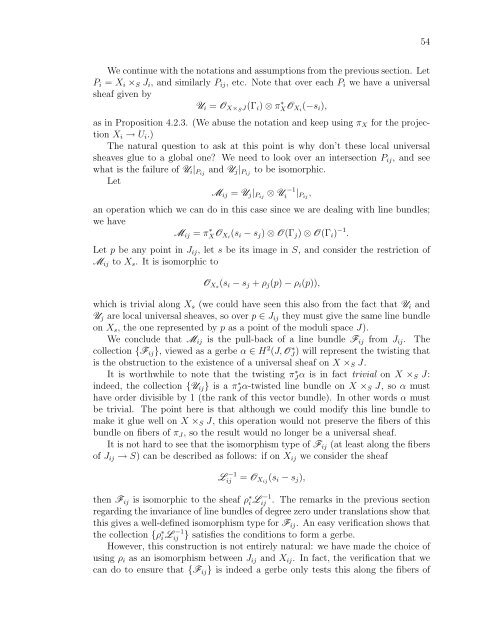derived categories of twisted sheaves on calabi-yau manifolds
derived categories of twisted sheaves on calabi-yau manifolds
derived categories of twisted sheaves on calabi-yau manifolds
You also want an ePaper? Increase the reach of your titles
YUMPU automatically turns print PDFs into web optimized ePapers that Google loves.
We c<strong>on</strong>tinue with the notati<strong>on</strong>s and assumpti<strong>on</strong>s from the previous secti<strong>on</strong>. Let<br />
Pi = Xi ×S Ji, and similarly Pij, etc. Note that over each Pi we have a universal<br />
sheaf given by<br />
Ui = OX×SJ(Γi) ⊗ π ∗ XOXi (−si),<br />
as in Propositi<strong>on</strong> 4.2.3. (We abuse the notati<strong>on</strong> and keep using πX for the projecti<strong>on</strong><br />
Xi → Ui.)<br />
The natural questi<strong>on</strong> to ask at this point is why d<strong>on</strong>’t these local universal<br />
<str<strong>on</strong>g>sheaves</str<strong>on</strong>g> glue to a global <strong>on</strong>e? We need to look over an intersecti<strong>on</strong> Pij, and see<br />
what is the failure <str<strong>on</strong>g>of</str<strong>on</strong>g> Ui|Pij and Uj|Pij to be isomorphic.<br />
Let<br />
Mij = Uj|Pij<br />
⊗ U −1<br />
i |Pij ,<br />
an operati<strong>on</strong> which we can do in this case since we are dealing with line bundles;<br />
we have<br />
Mij = π ∗ XOXi (si − sj) ⊗ O(Γj) ⊗ O(Γi) −1 .<br />
Let p be any point in Jij, let s be its image in S, and c<strong>on</strong>sider the restricti<strong>on</strong> <str<strong>on</strong>g>of</str<strong>on</strong>g><br />
Mij to Xs. It is isomorphic to<br />
OXs(si − sj + ρj(p) − ρi(p)),<br />
which is trivial al<strong>on</strong>g Xs (we could have seen this also from the fact that Ui and<br />
Uj are local universal <str<strong>on</strong>g>sheaves</str<strong>on</strong>g>, so over p ∈ Jij they must give the same line bundle<br />
<strong>on</strong> Xs, the <strong>on</strong>e represented by p as a point <str<strong>on</strong>g>of</str<strong>on</strong>g> the moduli space J).<br />
We c<strong>on</strong>clude that Mij is the pull-back <str<strong>on</strong>g>of</str<strong>on</strong>g> a line bundle Fij from Jij. The<br />
collecti<strong>on</strong> {Fij}, viewed as a gerbe α ∈ H 2 (J, O ∗ J<br />
54<br />
) will represent the twisting that<br />
is the obstructi<strong>on</strong> to the existence <str<strong>on</strong>g>of</str<strong>on</strong>g> a universal sheaf <strong>on</strong> X ×S J.<br />
It is worthwhile to note that the twisting π ∗ J α is in fact trivial <strong>on</strong> X ×S J:<br />
indeed, the collecti<strong>on</strong> {Uij} is a π ∗ J α-<str<strong>on</strong>g>twisted</str<strong>on</strong>g> line bundle <strong>on</strong> X ×S J, so α must<br />
have order divisible by 1 (the rank <str<strong>on</strong>g>of</str<strong>on</strong>g> this vector bundle). In other words α must<br />
be trivial. The point here is that although we could modify this line bundle to<br />
make it glue well <strong>on</strong> X ×S J, this operati<strong>on</strong> would not preserve the fibers <str<strong>on</strong>g>of</str<strong>on</strong>g> this<br />
bundle <strong>on</strong> fibers <str<strong>on</strong>g>of</str<strong>on</strong>g> πJ, so the result would no l<strong>on</strong>ger be a universal sheaf.<br />
It is not hard to see that the isomorphism type <str<strong>on</strong>g>of</str<strong>on</strong>g> Fij (at least al<strong>on</strong>g the fibers<br />
<str<strong>on</strong>g>of</str<strong>on</strong>g> Jij → S) can be described as follows: if <strong>on</strong> Xij we c<strong>on</strong>sider the sheaf<br />
L −1<br />
ij = OXij (si − sj),<br />
then Fij is isomorphic to the sheaf ρ ∗ i L −1<br />
ij . The remarks in the previous secti<strong>on</strong><br />
regarding the invariance <str<strong>on</strong>g>of</str<strong>on</strong>g> line bundles <str<strong>on</strong>g>of</str<strong>on</strong>g> degree zero under translati<strong>on</strong>s show that<br />
this gives a well-defined isomorphism type for Fij. An easy verificati<strong>on</strong> shows that<br />
} satisfies the c<strong>on</strong>diti<strong>on</strong>s to form a gerbe.<br />
the collecti<strong>on</strong> {ρ∗ i L −1<br />
ij<br />
However, this c<strong>on</strong>structi<strong>on</strong> is not entirely natural: we have made the choice <str<strong>on</strong>g>of</str<strong>on</strong>g><br />
using ρi as an isomorphism between Jij and Xij. In fact, the verificati<strong>on</strong> that we<br />
can do to ensure that {Fij} is indeed a gerbe <strong>on</strong>ly tests this al<strong>on</strong>g the fibers <str<strong>on</strong>g>of</str<strong>on</strong>g>
















